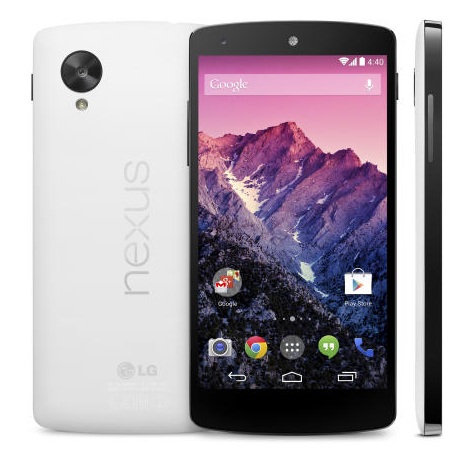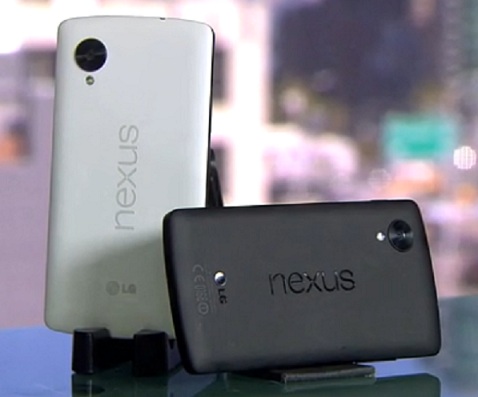Following yet another round of extensive leaks and rumors, yesterday – on that most hallowed of days, Halloween – Google finally unleashed its new flagship device, the LG-build Nexus 5. Along with the new device came the official launch of the next revision of Android, v4.4, aka KitKat (finally, we can say adios to “Key Lime Pie”). The new Nexus 5 and KitKat play off each other, of course, with Google delivering a number of new operating system features that give the Nexus 5 a certain cool groove (hmm, a rather retro description there, but it fits).
The most interesting thing about KitKat however isn’t so much the feature set as the fact that Google has managed to squeeze everything into an operating system that, if need be, can now be squeezed into 512 MB of storage. This means that the newest version of Android can now be placed on fairly inexpensive new smartphones. The hope here, in part, is to significantly reduce Android version fragmentation.
With both high end and lower end phones able to run the same Android version, Google can now begin to look forward to claiming a higher percentage (a “much higher” percentage) of users running the same advanced version of the OS. Over the years the claims have been that at an one time no more that 15 percent or so of all Android phones ever run the latest version of the OS. Apple has long held an advantage here – most recently it claimed that 64 percent of all iOS users had already upgraded to iOS 7, with most of the rest expected to follow suit.
Android KitKat Features
KitKat will deliver faster multitasking, as well as full voice control. It will also offer a new caller ID system capability that will try to guess who is calling if the number is not in a user’s contact list. How so? KitKat will take a shot at making a guess by comparing the number to businesses that are listed on Google Maps. We’re truly not sure why Google thinks this is a benefit - we would anticipate the odds of it being such a number to be quite low. Yet there it is.
KitKat will also offer a perhaps somewhat more directly handy set of features. These include a solution to the eternal problem of wanting to print from your mobile device. There are solutions out there but for most people these solutions tend to be beyond their typical levels of endurance in trying to make things work. KitKat will try to ease the pain…just a bit perhaps. KitKat-enabled devices will be able to send documents directly to printers by using either Google Cloud Print or HP's ePrint system. We are not sure yet how KitKat will make things any easier however.
And, Quickoffice and Android’s email app have both undergone upgrades. Will either truly be easier to use? How many people use Quickoffice? We don’t know but we ourselves do not. Will finding files more easily and a simpler ability to edit documents and spreadsheets really make a difference and increase usage? Probably not.
Google Voice Search and Google Now have also been updated. Several new cards have been added to Google Now, including one that keeps you updated on your favorite TV shows. It can also tailor search results to bring you summaries of your preferred topics.
Finally, as we noted above, KitKat will be able to run on a wider variety of hardware than earlier devices due to optimizations that will KitKat to run within 512 MB of memory. The operating system is smart enough to know to close down certain services to optimize overall size. Even so, we wonder just how well this new capability will work within 512 MB – only longer term testing will tell. Will KitKat become sluggish and less crisp? When coupled with the less able processors found on less expensive smartphones we have to wonder – we suspect it will become sluggish, though perhaps users of lower end devices will be glad to trade off performance levels in order to be able to play with the latest version of the OS. Time will, again, tell.
Regardless of what we’ve just noted about squeezing into lower end devices, Google isn’t in any particular rush to make this all a reality. The initial release will only target high end hardware – the Nexus 5 of course, the Nexus 4, 7 and 10 of course, the Samsung Galaxy S4 (clearly a must), and the HTC One Google Play edition.
Nexus 5 – Any Color You Want: Black or White
And what of the new Google flagship Nexus 5 that was also just announced? To begin with, LG is yet again behind it all. Some had thought that perhaps Google would finally turn to Motorola for its next flagship but that has turned out to not be the case. In a way it is rather confusing.
A possible message takeaway here is that Google doesn’t believe the Moto X “super smartphone” is good enough to own Google’s flagship status. The Nexus 5 now stands ahead of it in terms of the highest end device Google itself delivers on. Interestingly, in polar opposite of the Moto X and its myriad available colors and customizations, the Nexus 5 will come in a bold selection of its own colors – white or black, finished in a nice soft touch plastic. There are no “hard shell” plastic case pieces here – it’s a good touch but reminds us entirely of the BlackBerry Z10, Z30 and Q10 case finishes.
In any case, here is what the new toy looks like:

When we first covered the Moto X we noted that the ability to extensively tweak colors and manage personalization choices is a very consumer-focused kind of thing that appeals to a very specific market segment of younger folks – typically tweens. Perhaps with the Nexus 5 the company is looking to really deliver a far more “professional” and minimalist statement that the Nexus 5 is your serious business device as well as your most high powered personal phone. That is certainly how we are reading it today as we write – on the surface that looks to us to be the clear distinction.
That leaves open for speculation where the next Nexus flagship smartphone (and even tablet) may come from. We have to believe that at some point Motorola will take center stage here. Maybe next time.
It is notable that the new device does not sport any of LG’s latest innovations – the back of case controls launched with the LG G2, or the curved design or any hints of it as with the LG G Flex. Rather the Nexus 5, with its standard side-based controls, just looks extraordinarily “old school.” It really does (as do Blackberry’s devices) even though there is a tiny bit of sleekness to it. Ok, per Google the buttons are made of a ceramic material – that is surely high tech, but…
Here are the formal specifications:
- Processor: Qualcomm Snapdragon 800, 2.26 GHz;
- GPU: Adreno 330, 450MHz;
- Operating System: Android 4.4, KitKat;
- Memory: Choose 16 GB or 32 GB internal storage (actual formatted capacity will be less); 2 GB RAM; microUSB; SlimPort enabled;
- Sensors: GPS; Gyroscope; Accelerometer; Compass; Proximity/Ambient Light; Pressure; Hall;
- Networks (North America): GSM: 850/900/1800/1900 MHz; CDMA: Band Class: 0/1/10; WCDMA: Bands: 1/2/4/5/6/8/19; LTE: Bands: 1/2/4/5/17/19/25/26/41;
- Networks (Global): GSM: 850/900/1800/1900 MHz; WCDMA: Bands: 1/2/4/5/6/8; LTE: Bands: 1/3/5/7/8/20;
- Wireless Connectivity: Dualband WiFi (2.4G/5G) 802.11 a/b/g/n/ac NFC (Android Beam); Bluetooth 4.0;
- Screen: 4.95 inch, 1920 x 1080 display at 445 ppi; Full HD IPS; Corning Gorilla Glass 3;
- Cameras: 8 MP rear facing with Optical Image Stabilization; 1.3 MP front facing;
- Audio: Built-in speaker, 3.5mm stereo audio connector;
- Ports and Connectors: 3.5mm stereo audio jack; Dual microphones; Ceramic power and volume buttons;
- Dimensions: 69.17 x 137.84 x 8.59mm;
- Weight: 4.59 ounces (130g);
- Battery: 2300 mAh; Talk time up to 17 hours; Standby time up to 300 hours; Internet use time up to 8.5 hours on WiFi, up to 7 hours on LTE;
- Wireless Charging: Built-in.
There simply isn’t anything here that stands out in any special way. Yes, it is certainly slimmer than previous models (to be expected), it is fairly light (to be expected), the battery is average (we might have expected something heftier for a serious business device), and the camera is quite ho hum at 8 MP. With Nokia completely redefining the state of the art in smartphone photography – not only with the flagship 1020 41 MP camera, but with the new large screen 1520 20 MP camera as well, delivering an 8 MP camera (yes, there is a new HDR+ mode, that is to be expected) at this juncture does not strike us as compelling.

Google made mention of a small gyroscope embedded as part of the camera assembly to help with image stabilization, but is this a gimmick or an advancement? The jury is out but it’s not enough to push the camera technology over the top in any way.
Did we mention there is no microSD slot (that was not expected to be the case)? Horror – there is the Halloween angle! So where is the win here?
Well, as with most Google hardware it is priced to sell across a great many income levels. When considered relative to Google’s pricing scheme for it, it really is an affordable device. The Nexus 5 will starts at $349 for the 16 GB version and $399 for the 32 GB version, both unlocked –great prices! Will it be enough to drive significant sales? We just don’t know. It will be available on a global basis. In the United States all carriers will make it available with the singular exception of Verizon, which will not offer the Nexus 5.
We remain left with the conundrum of Moto X vs. Nexus 5. It strikes us that the two fight against each other rather than complimenting each other. We are already looking ahead to what the next Nexus smartphone will end up being. Our guess is that it will go the Moto X route. We’ll see.
Edited by
Ryan Sartor  QUICK LINKS
QUICK LINKS